Organisation Leadership and Management Report Analysis
VerifiedAdded on 2023/01/12
|17
|4804
|89
Report
AI Summary
This report provides a detailed analysis of leadership and management principles, focusing on their application within organisations, with Tesco as a case study. It begins with an introduction to management and leadership, differentiating between the two and highlighting their importance. The main body delves into various leadership and management theories, including trait theory and contingency theory, and how these are implemented in practice. The report also explores the roles of leaders and managers, emphasizing their responsibilities in decision-making, vision setting, resource allocation, and performance monitoring. Furthermore, the report discusses the similarities between leadership and management, stressing their collaborative efforts towards achieving organisational objectives. The report also covers leadership development programs, including the NHS program, its eligibility criteria, structure, and the benefits it offers to both individuals and organisations. The report concludes by summarizing the key findings and reinforcing the significance of effective leadership and management practices for organisational success.
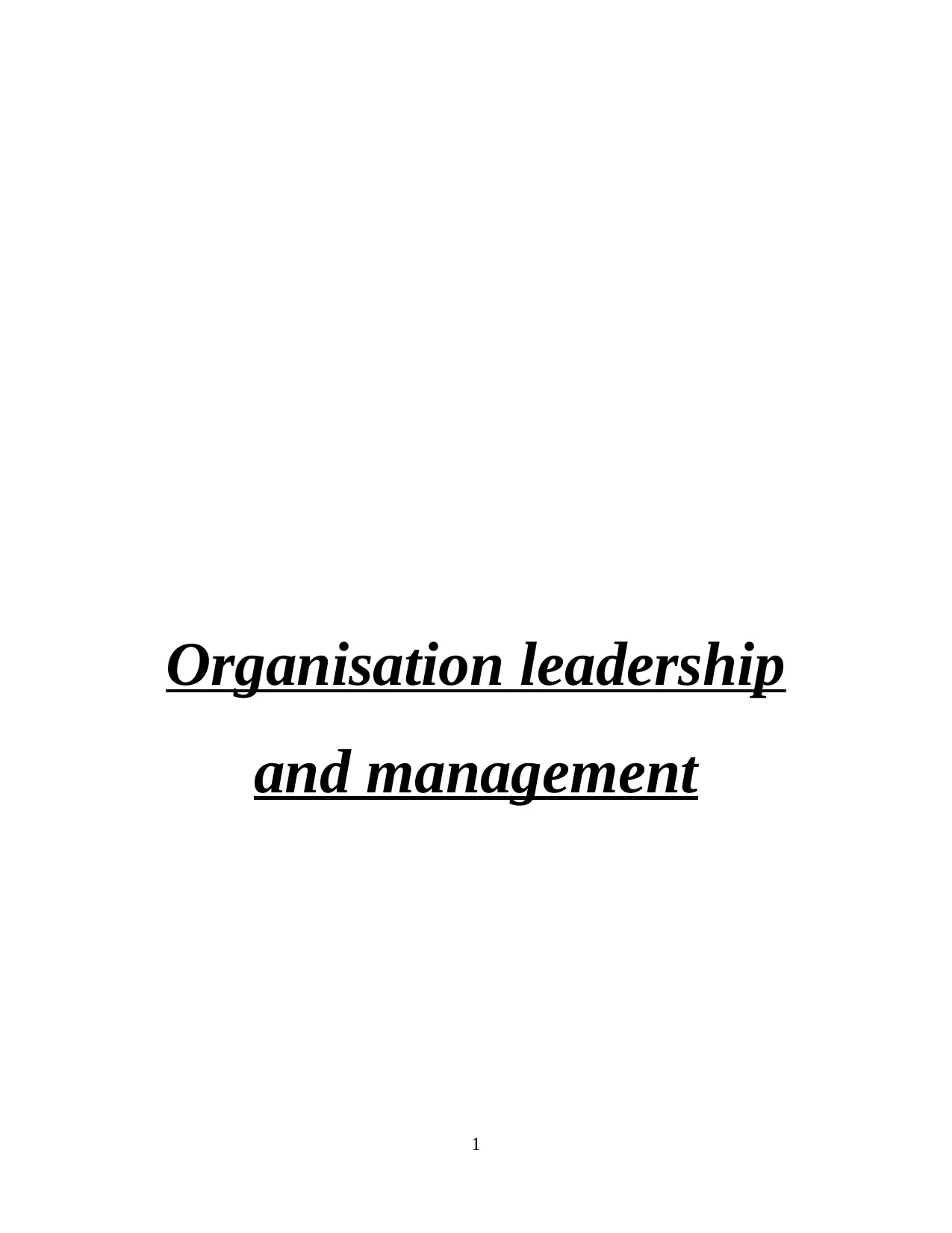
Organisation leadership
and management
1
and management
1
Paraphrase This Document
Need a fresh take? Get an instant paraphrase of this document with our AI Paraphraser
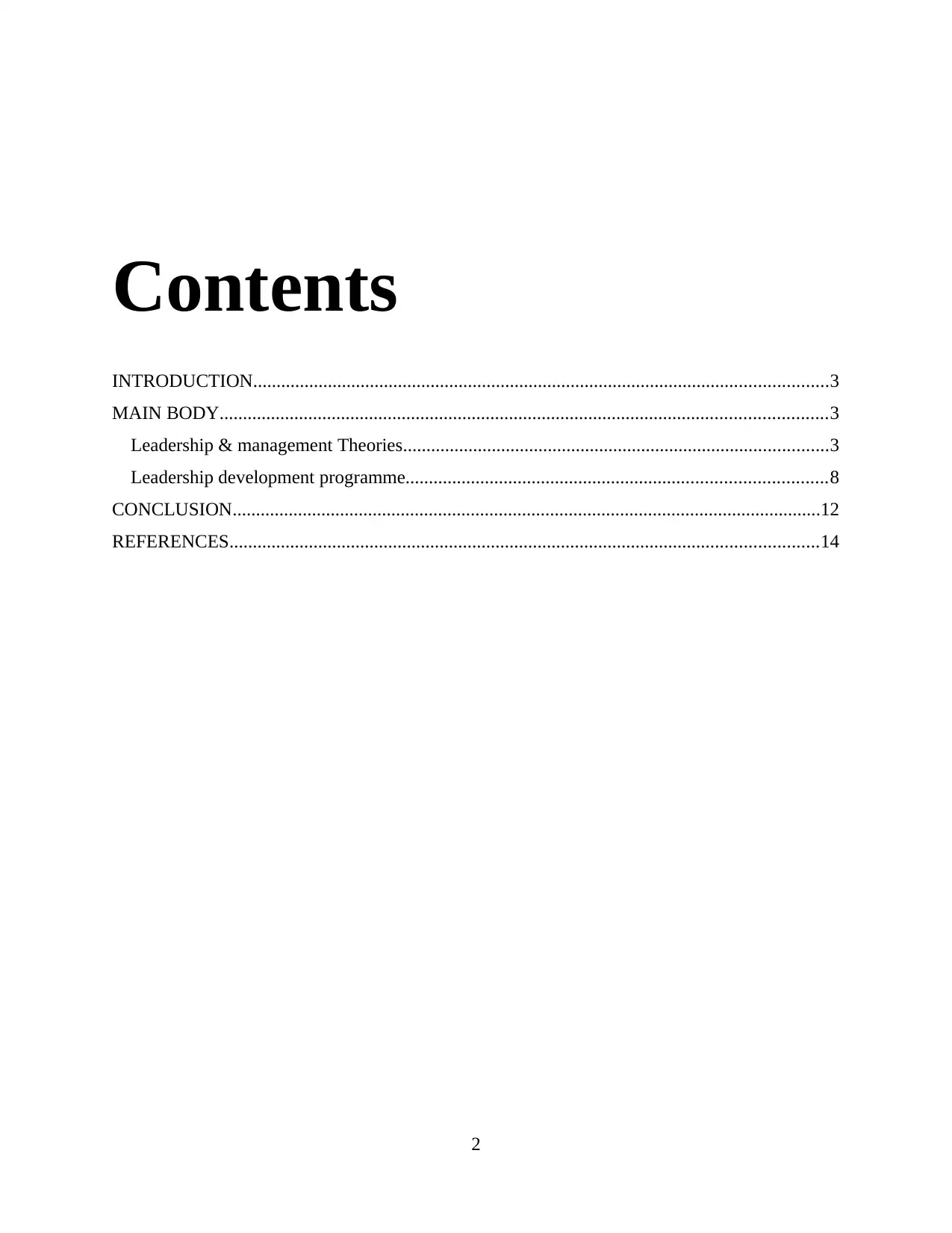
Contents
INTRODUCTION...........................................................................................................................3
MAIN BODY..................................................................................................................................3
Leadership & management Theories...........................................................................................3
Leadership development programme..........................................................................................8
CONCLUSION..............................................................................................................................12
REFERENCES..............................................................................................................................14
2
INTRODUCTION...........................................................................................................................3
MAIN BODY..................................................................................................................................3
Leadership & management Theories...........................................................................................3
Leadership development programme..........................................................................................8
CONCLUSION..............................................................................................................................12
REFERENCES..............................................................................................................................14
2
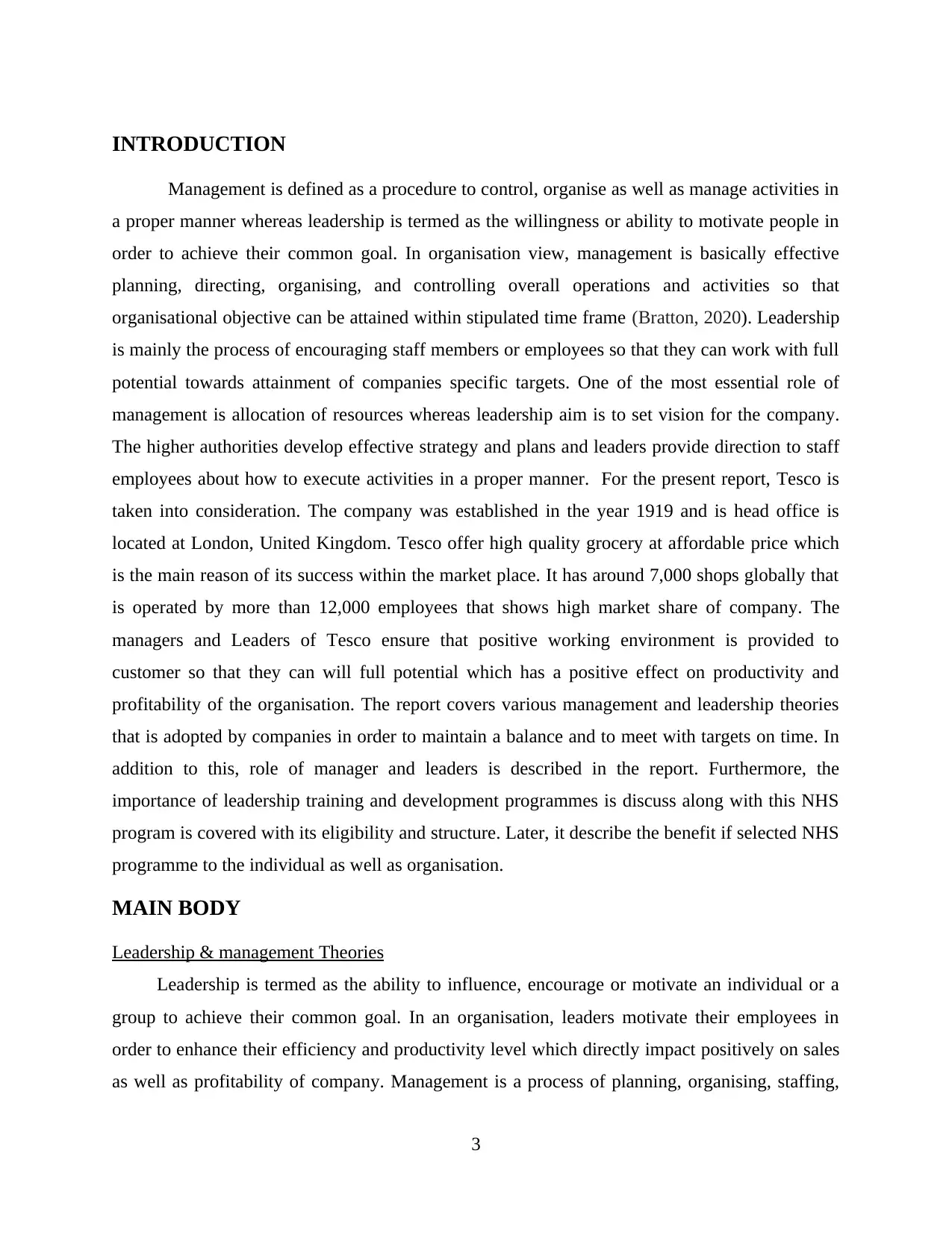
INTRODUCTION
Management is defined as a procedure to control, organise as well as manage activities in
a proper manner whereas leadership is termed as the willingness or ability to motivate people in
order to achieve their common goal. In organisation view, management is basically effective
planning, directing, organising, and controlling overall operations and activities so that
organisational objective can be attained within stipulated time frame (Bratton, 2020). Leadership
is mainly the process of encouraging staff members or employees so that they can work with full
potential towards attainment of companies specific targets. One of the most essential role of
management is allocation of resources whereas leadership aim is to set vision for the company.
The higher authorities develop effective strategy and plans and leaders provide direction to staff
employees about how to execute activities in a proper manner. For the present report, Tesco is
taken into consideration. The company was established in the year 1919 and is head office is
located at London, United Kingdom. Tesco offer high quality grocery at affordable price which
is the main reason of its success within the market place. It has around 7,000 shops globally that
is operated by more than 12,000 employees that shows high market share of company. The
managers and Leaders of Tesco ensure that positive working environment is provided to
customer so that they can will full potential which has a positive effect on productivity and
profitability of the organisation. The report covers various management and leadership theories
that is adopted by companies in order to maintain a balance and to meet with targets on time. In
addition to this, role of manager and leaders is described in the report. Furthermore, the
importance of leadership training and development programmes is discuss along with this NHS
program is covered with its eligibility and structure. Later, it describe the benefit if selected NHS
programme to the individual as well as organisation.
MAIN BODY
Leadership & management Theories
Leadership is termed as the ability to influence, encourage or motivate an individual or a
group to achieve their common goal. In an organisation, leaders motivate their employees in
order to enhance their efficiency and productivity level which directly impact positively on sales
as well as profitability of company. Management is a process of planning, organising, staffing,
3
Management is defined as a procedure to control, organise as well as manage activities in
a proper manner whereas leadership is termed as the willingness or ability to motivate people in
order to achieve their common goal. In organisation view, management is basically effective
planning, directing, organising, and controlling overall operations and activities so that
organisational objective can be attained within stipulated time frame (Bratton, 2020). Leadership
is mainly the process of encouraging staff members or employees so that they can work with full
potential towards attainment of companies specific targets. One of the most essential role of
management is allocation of resources whereas leadership aim is to set vision for the company.
The higher authorities develop effective strategy and plans and leaders provide direction to staff
employees about how to execute activities in a proper manner. For the present report, Tesco is
taken into consideration. The company was established in the year 1919 and is head office is
located at London, United Kingdom. Tesco offer high quality grocery at affordable price which
is the main reason of its success within the market place. It has around 7,000 shops globally that
is operated by more than 12,000 employees that shows high market share of company. The
managers and Leaders of Tesco ensure that positive working environment is provided to
customer so that they can will full potential which has a positive effect on productivity and
profitability of the organisation. The report covers various management and leadership theories
that is adopted by companies in order to maintain a balance and to meet with targets on time. In
addition to this, role of manager and leaders is described in the report. Furthermore, the
importance of leadership training and development programmes is discuss along with this NHS
program is covered with its eligibility and structure. Later, it describe the benefit if selected NHS
programme to the individual as well as organisation.
MAIN BODY
Leadership & management Theories
Leadership is termed as the ability to influence, encourage or motivate an individual or a
group to achieve their common goal. In an organisation, leaders motivate their employees in
order to enhance their efficiency and productivity level which directly impact positively on sales
as well as profitability of company. Management is a process of planning, organising, staffing,
3
⊘ This is a preview!⊘
Do you want full access?
Subscribe today to unlock all pages.

Trusted by 1+ million students worldwide

directing & controlling of all the activities and operation of an entity in a proper manner. The
higher authorities of company create policies and strategies that is implemented by employees in
an effective manner (Al-Ali, 2017). For this, leaders encourage staff members and give them
guidance to appropriately carry out activities that leads to achievement of organisational
objectives or goals within specified time period. It has been analysed that effective leader and
manager is one who take up the company towards higher growth as well as success at
marketplace. With reference to Tesco, its higher authorities continuously check activities that is
implement by staff members so that improvements can be done and better quality is provided to
customers that leads to enhancement in profitability of Tesco. The leaders of Tesco keep on
encouraging its staff members as company also provide financial and non-financial benefits to
employees as per their performance and input put towards targets. This help company to raise
productivity as well as efficiency of manpower which directly leads to increase in profits of
organisation. Its leaders adopt various leadership style and theories such as contingency theory
and participative leadership style that help in meeting with targets in proper manner. In addition
to this, Tesco allows staff members to take part in decision making so that some innovative and
beneficial idea is developed which has a positive effect on performance of company at market
place. It also assist organisation to enhance confidence level and boost the morale of workers
prevailing within the company. Its leaders ensure that proper training session is given to
employees so that they can easily handle customer queries and provide them high customer
experience that leads to increase in reputation and market position of company in an effective
manner.
Role of Leader:
Leaders give direction to employees that is associated with goals and objectives of an
organisation. Along with this, Leaders encourage all the employees prevailing at workplace so
that they can implement out activities in proper manner. The leader’s role in an organisation are
as follows:
Decision maker: The leaders of company take decision after identifying the situations
and conditions of an organisation. In addition to this, they study out all the strategies and
objectives of company and then take decision which is beneficial for both the employees and
entity as well. The decision taken by leaders plays an important role as overall growth and
success is depend on them. It is essential for leaders to have effective interaction and
4
higher authorities of company create policies and strategies that is implemented by employees in
an effective manner (Al-Ali, 2017). For this, leaders encourage staff members and give them
guidance to appropriately carry out activities that leads to achievement of organisational
objectives or goals within specified time period. It has been analysed that effective leader and
manager is one who take up the company towards higher growth as well as success at
marketplace. With reference to Tesco, its higher authorities continuously check activities that is
implement by staff members so that improvements can be done and better quality is provided to
customers that leads to enhancement in profitability of Tesco. The leaders of Tesco keep on
encouraging its staff members as company also provide financial and non-financial benefits to
employees as per their performance and input put towards targets. This help company to raise
productivity as well as efficiency of manpower which directly leads to increase in profits of
organisation. Its leaders adopt various leadership style and theories such as contingency theory
and participative leadership style that help in meeting with targets in proper manner. In addition
to this, Tesco allows staff members to take part in decision making so that some innovative and
beneficial idea is developed which has a positive effect on performance of company at market
place. It also assist organisation to enhance confidence level and boost the morale of workers
prevailing within the company. Its leaders ensure that proper training session is given to
employees so that they can easily handle customer queries and provide them high customer
experience that leads to increase in reputation and market position of company in an effective
manner.
Role of Leader:
Leaders give direction to employees that is associated with goals and objectives of an
organisation. Along with this, Leaders encourage all the employees prevailing at workplace so
that they can implement out activities in proper manner. The leader’s role in an organisation are
as follows:
Decision maker: The leaders of company take decision after identifying the situations
and conditions of an organisation. In addition to this, they study out all the strategies and
objectives of company and then take decision which is beneficial for both the employees and
entity as well. The decision taken by leaders plays an important role as overall growth and
success is depend on them. It is essential for leaders to have effective interaction and
4
Paraphrase This Document
Need a fresh take? Get an instant paraphrase of this document with our AI Paraphraser

communication skills that help in sharing decision taken by them to staff members in a proper as
well as effective manner.
Vision setting: It is defined as one of the most essential role which si performed by
leaders in an appropriate manner. They set vision which is wholly associated with targets and
goals of an organisation. It is important for a leader to have willingness to set vision and
communicate it to all the staff members that ensure attainment of objectives within given time
frame. In addition to this, it also ensure a company to implement out activities by employees in a
proper as well as smooth manner.
Role of a manager
In every organisation, managers plays an important role as they develop effective
strategies, policies that is beneficial and feasible for company to gain higher success and growth
at marketplace. There are various role that is performed by higher authorities or managers are as
follows:
Proper allocation of resources: In order to gain growth, it is important for an
organisation to effectively use all the resources as it cut down the cost which leads to earning of
higher profits. It is the responsibility of managers to optimally utilise all resources such as
machine, material, employees, capital so that efficiency if company is increases. By the
assistance of this, companies is also able to maintain a balance between demand and supply
which impact positively on the market position and efficiency of an organisation.
Monitoring & Evaluation: The higher authorities check and monitor performance as
well as efficiency of employees with the expected performance and then provide feedback
accordingly so that improvements can be done and quality of products and service is maintained.
The mangers evaluate performance of staff members that is whether operations or activities
carried out by them is appropriate or not. This assist companies to offer high quality goods and
service to customer and increase reputation within the market effectively.
Similarities between Leadership and management
There are many similarities between leadership and management which is described
below:
It is determined that both the leaders as well as mangers perform their work in order to
achieve organisational objectives within specified time frame. Along with this, their aim
is to meet with the targets in a proper manner.
5
well as effective manner.
Vision setting: It is defined as one of the most essential role which si performed by
leaders in an appropriate manner. They set vision which is wholly associated with targets and
goals of an organisation. It is important for a leader to have willingness to set vision and
communicate it to all the staff members that ensure attainment of objectives within given time
frame. In addition to this, it also ensure a company to implement out activities by employees in a
proper as well as smooth manner.
Role of a manager
In every organisation, managers plays an important role as they develop effective
strategies, policies that is beneficial and feasible for company to gain higher success and growth
at marketplace. There are various role that is performed by higher authorities or managers are as
follows:
Proper allocation of resources: In order to gain growth, it is important for an
organisation to effectively use all the resources as it cut down the cost which leads to earning of
higher profits. It is the responsibility of managers to optimally utilise all resources such as
machine, material, employees, capital so that efficiency if company is increases. By the
assistance of this, companies is also able to maintain a balance between demand and supply
which impact positively on the market position and efficiency of an organisation.
Monitoring & Evaluation: The higher authorities check and monitor performance as
well as efficiency of employees with the expected performance and then provide feedback
accordingly so that improvements can be done and quality of products and service is maintained.
The mangers evaluate performance of staff members that is whether operations or activities
carried out by them is appropriate or not. This assist companies to offer high quality goods and
service to customer and increase reputation within the market effectively.
Similarities between Leadership and management
There are many similarities between leadership and management which is described
below:
It is determined that both the leaders as well as mangers perform their work in order to
achieve organisational objectives within specified time frame. Along with this, their aim
is to meet with the targets in a proper manner.
5
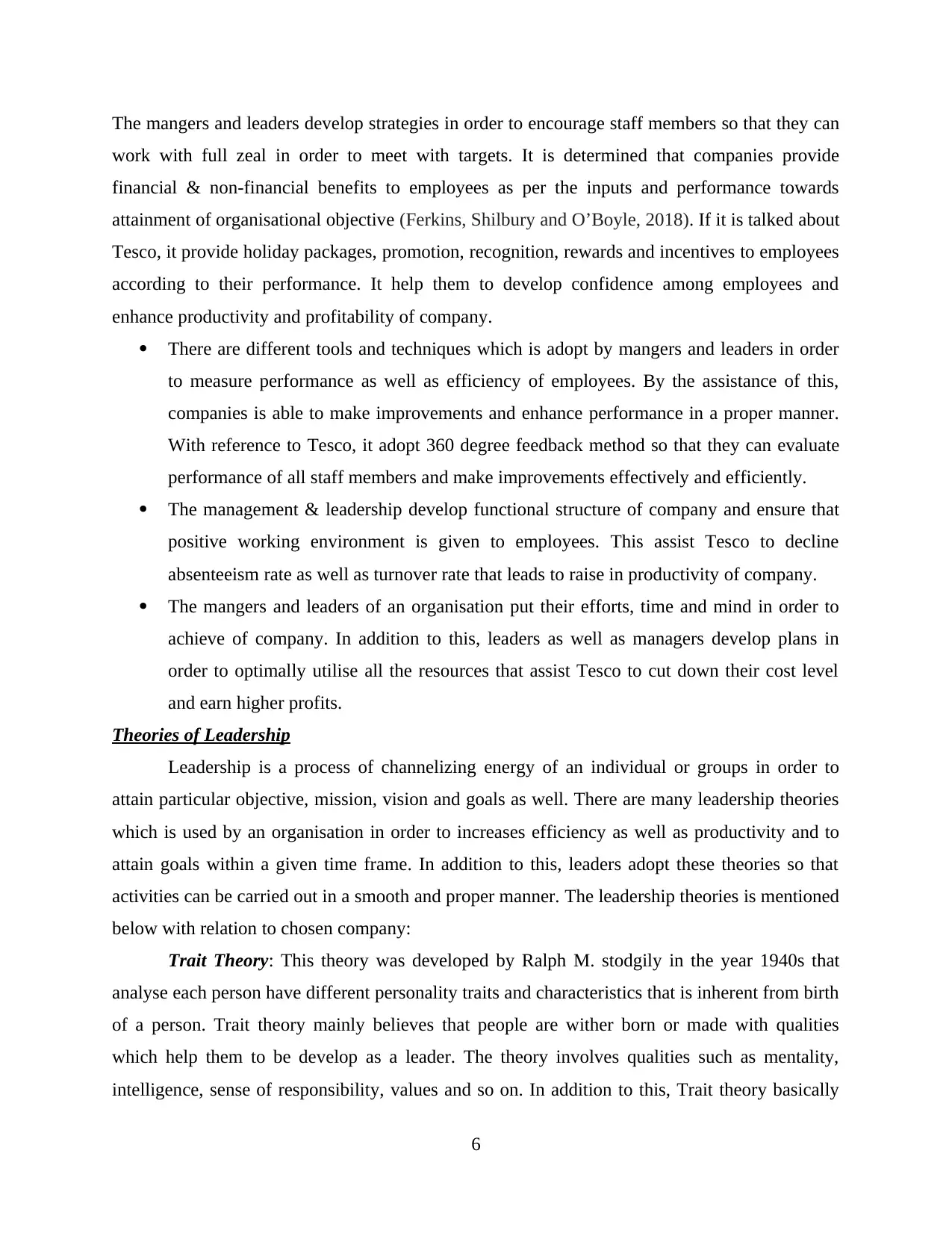
The mangers and leaders develop strategies in order to encourage staff members so that they can
work with full zeal in order to meet with targets. It is determined that companies provide
financial & non-financial benefits to employees as per the inputs and performance towards
attainment of organisational objective (Ferkins, Shilbury and O’Boyle, 2018). If it is talked about
Tesco, it provide holiday packages, promotion, recognition, rewards and incentives to employees
according to their performance. It help them to develop confidence among employees and
enhance productivity and profitability of company.
There are different tools and techniques which is adopt by mangers and leaders in order
to measure performance as well as efficiency of employees. By the assistance of this,
companies is able to make improvements and enhance performance in a proper manner.
With reference to Tesco, it adopt 360 degree feedback method so that they can evaluate
performance of all staff members and make improvements effectively and efficiently.
The management & leadership develop functional structure of company and ensure that
positive working environment is given to employees. This assist Tesco to decline
absenteeism rate as well as turnover rate that leads to raise in productivity of company.
The mangers and leaders of an organisation put their efforts, time and mind in order to
achieve of company. In addition to this, leaders as well as managers develop plans in
order to optimally utilise all the resources that assist Tesco to cut down their cost level
and earn higher profits.
Theories of Leadership
Leadership is a process of channelizing energy of an individual or groups in order to
attain particular objective, mission, vision and goals as well. There are many leadership theories
which is used by an organisation in order to increases efficiency as well as productivity and to
attain goals within a given time frame. In addition to this, leaders adopt these theories so that
activities can be carried out in a smooth and proper manner. The leadership theories is mentioned
below with relation to chosen company:
Trait Theory: This theory was developed by Ralph M. stodgily in the year 1940s that
analyse each person have different personality traits and characteristics that is inherent from birth
of a person. Trait theory mainly believes that people are wither born or made with qualities
which help them to be develop as a leader. The theory involves qualities such as mentality,
intelligence, sense of responsibility, values and so on. In addition to this, Trait theory basically
6
work with full zeal in order to meet with targets. It is determined that companies provide
financial & non-financial benefits to employees as per the inputs and performance towards
attainment of organisational objective (Ferkins, Shilbury and O’Boyle, 2018). If it is talked about
Tesco, it provide holiday packages, promotion, recognition, rewards and incentives to employees
according to their performance. It help them to develop confidence among employees and
enhance productivity and profitability of company.
There are different tools and techniques which is adopt by mangers and leaders in order
to measure performance as well as efficiency of employees. By the assistance of this,
companies is able to make improvements and enhance performance in a proper manner.
With reference to Tesco, it adopt 360 degree feedback method so that they can evaluate
performance of all staff members and make improvements effectively and efficiently.
The management & leadership develop functional structure of company and ensure that
positive working environment is given to employees. This assist Tesco to decline
absenteeism rate as well as turnover rate that leads to raise in productivity of company.
The mangers and leaders of an organisation put their efforts, time and mind in order to
achieve of company. In addition to this, leaders as well as managers develop plans in
order to optimally utilise all the resources that assist Tesco to cut down their cost level
and earn higher profits.
Theories of Leadership
Leadership is a process of channelizing energy of an individual or groups in order to
attain particular objective, mission, vision and goals as well. There are many leadership theories
which is used by an organisation in order to increases efficiency as well as productivity and to
attain goals within a given time frame. In addition to this, leaders adopt these theories so that
activities can be carried out in a smooth and proper manner. The leadership theories is mentioned
below with relation to chosen company:
Trait Theory: This theory was developed by Ralph M. stodgily in the year 1940s that
analyse each person have different personality traits and characteristics that is inherent from birth
of a person. Trait theory mainly believes that people are wither born or made with qualities
which help them to be develop as a leader. The theory involves qualities such as mentality,
intelligence, sense of responsibility, values and so on. In addition to this, Trait theory basically
6
⊘ This is a preview!⊘
Do you want full access?
Subscribe today to unlock all pages.

Trusted by 1+ million students worldwide

focuses on analysing mental and physical characteristics in order to gain an insight regarding
combination of characteristics that is common among leaders. Trait theory is divided into several
traits which is given below:
Personality Traits: There are many forms of personality of an individual or a leaders such
as honesty, agreeable, patience, extrovert, innovation and many more.
Task related Traits: It involve traits that us determination towards work, initiative,
business experience, attainment drive, decisiveness and so on.
Physiological Traits: The physiological traits include height, colour, weight, appearance
and many more traits of a leader and individual.
Intellectual Traits: It is essential for a leader to have intellectual skills which will help
them to cope up with the situations in an effective manner (Elliott, 2017). The intellectual traits
involves emotional attribute, decisiveness, intelligence, willingness to judge and many more.
Social characteristics: This leadership trait plays vital role in order to effectively maintain
good relation with other people and other staff members working within the organisation. The
social characteristics are cooperation, social active, cordiality and so on.
In addition to this, there are other traits also that is undertaken are creativity, flexibility,
uniqueness, ability to cope with changes, charisma etc. One of the drawback of Trait theory is it
does not undertake environmental factors which does not remain same. With reference to Tesco,
its mangers and leaders use this theory at workplace that help company to identify personality
characteristics of staff members in an appropriate manner. By the assistance of this, its managers
and leaders delegate authority and responsibility as per the personality type of staff members so
that they take interest in activities and implement them in a proper manner. Moreover, it help
Tesco to increase productivity level of employees which has a positive impact on sales and
profitability of company.
Contingency Theory: This theory mainly focuses on particular variables that is related to
environment and identify which particular leadership style is feasible to handle particular
conditions and situations. According to this theory, there is no specific leadership style is suited
in all the situations occurred, it is change according the situations and conditions. Contingency
theory is basically the extension of Trait theory. It has been identified that leaders express their
skills when they perceive that followers will give response to them in a proper manner. Herein,
different models is developed that is given below:
7
combination of characteristics that is common among leaders. Trait theory is divided into several
traits which is given below:
Personality Traits: There are many forms of personality of an individual or a leaders such
as honesty, agreeable, patience, extrovert, innovation and many more.
Task related Traits: It involve traits that us determination towards work, initiative,
business experience, attainment drive, decisiveness and so on.
Physiological Traits: The physiological traits include height, colour, weight, appearance
and many more traits of a leader and individual.
Intellectual Traits: It is essential for a leader to have intellectual skills which will help
them to cope up with the situations in an effective manner (Elliott, 2017). The intellectual traits
involves emotional attribute, decisiveness, intelligence, willingness to judge and many more.
Social characteristics: This leadership trait plays vital role in order to effectively maintain
good relation with other people and other staff members working within the organisation. The
social characteristics are cooperation, social active, cordiality and so on.
In addition to this, there are other traits also that is undertaken are creativity, flexibility,
uniqueness, ability to cope with changes, charisma etc. One of the drawback of Trait theory is it
does not undertake environmental factors which does not remain same. With reference to Tesco,
its mangers and leaders use this theory at workplace that help company to identify personality
characteristics of staff members in an appropriate manner. By the assistance of this, its managers
and leaders delegate authority and responsibility as per the personality type of staff members so
that they take interest in activities and implement them in a proper manner. Moreover, it help
Tesco to increase productivity level of employees which has a positive impact on sales and
profitability of company.
Contingency Theory: This theory mainly focuses on particular variables that is related to
environment and identify which particular leadership style is feasible to handle particular
conditions and situations. According to this theory, there is no specific leadership style is suited
in all the situations occurred, it is change according the situations and conditions. Contingency
theory is basically the extension of Trait theory. It has been identified that leaders express their
skills when they perceive that followers will give response to them in a proper manner. Herein,
different models is developed that is given below:
7
Paraphrase This Document
Need a fresh take? Get an instant paraphrase of this document with our AI Paraphraser
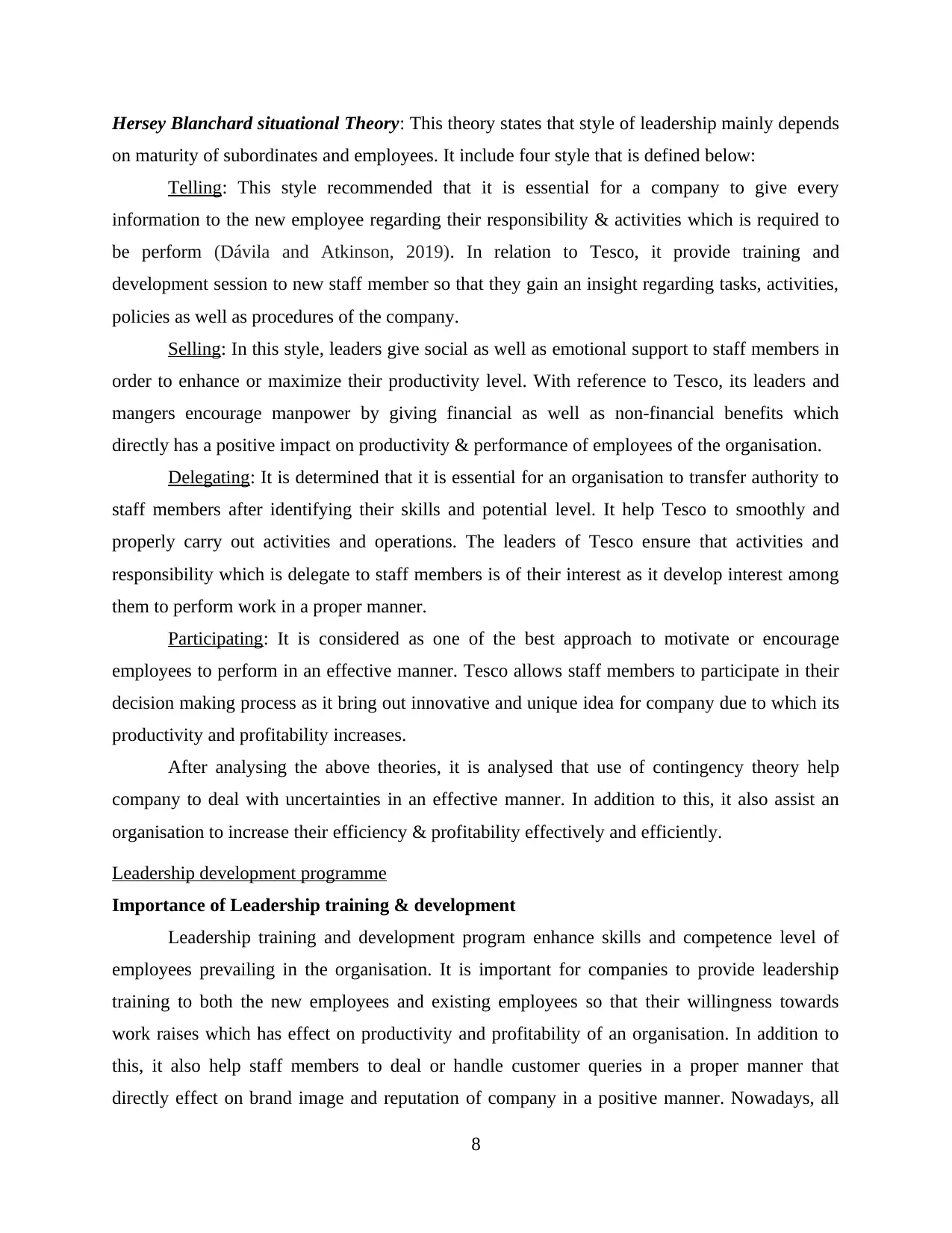
Hersey Blanchard situational Theory: This theory states that style of leadership mainly depends
on maturity of subordinates and employees. It include four style that is defined below:
Telling: This style recommended that it is essential for a company to give every
information to the new employee regarding their responsibility & activities which is required to
be perform (Dávila and Atkinson, 2019). In relation to Tesco, it provide training and
development session to new staff member so that they gain an insight regarding tasks, activities,
policies as well as procedures of the company.
Selling: In this style, leaders give social as well as emotional support to staff members in
order to enhance or maximize their productivity level. With reference to Tesco, its leaders and
mangers encourage manpower by giving financial as well as non-financial benefits which
directly has a positive impact on productivity & performance of employees of the organisation.
Delegating: It is determined that it is essential for an organisation to transfer authority to
staff members after identifying their skills and potential level. It help Tesco to smoothly and
properly carry out activities and operations. The leaders of Tesco ensure that activities and
responsibility which is delegate to staff members is of their interest as it develop interest among
them to perform work in a proper manner.
Participating: It is considered as one of the best approach to motivate or encourage
employees to perform in an effective manner. Tesco allows staff members to participate in their
decision making process as it bring out innovative and unique idea for company due to which its
productivity and profitability increases.
After analysing the above theories, it is analysed that use of contingency theory help
company to deal with uncertainties in an effective manner. In addition to this, it also assist an
organisation to increase their efficiency & profitability effectively and efficiently.
Leadership development programme
Importance of Leadership training & development
Leadership training and development program enhance skills and competence level of
employees prevailing in the organisation. It is important for companies to provide leadership
training to both the new employees and existing employees so that their willingness towards
work raises which has effect on productivity and profitability of an organisation. In addition to
this, it also help staff members to deal or handle customer queries in a proper manner that
directly effect on brand image and reputation of company in a positive manner. Nowadays, all
8
on maturity of subordinates and employees. It include four style that is defined below:
Telling: This style recommended that it is essential for a company to give every
information to the new employee regarding their responsibility & activities which is required to
be perform (Dávila and Atkinson, 2019). In relation to Tesco, it provide training and
development session to new staff member so that they gain an insight regarding tasks, activities,
policies as well as procedures of the company.
Selling: In this style, leaders give social as well as emotional support to staff members in
order to enhance or maximize their productivity level. With reference to Tesco, its leaders and
mangers encourage manpower by giving financial as well as non-financial benefits which
directly has a positive impact on productivity & performance of employees of the organisation.
Delegating: It is determined that it is essential for an organisation to transfer authority to
staff members after identifying their skills and potential level. It help Tesco to smoothly and
properly carry out activities and operations. The leaders of Tesco ensure that activities and
responsibility which is delegate to staff members is of their interest as it develop interest among
them to perform work in a proper manner.
Participating: It is considered as one of the best approach to motivate or encourage
employees to perform in an effective manner. Tesco allows staff members to participate in their
decision making process as it bring out innovative and unique idea for company due to which its
productivity and profitability increases.
After analysing the above theories, it is analysed that use of contingency theory help
company to deal with uncertainties in an effective manner. In addition to this, it also assist an
organisation to increase their efficiency & profitability effectively and efficiently.
Leadership development programme
Importance of Leadership training & development
Leadership training and development program enhance skills and competence level of
employees prevailing in the organisation. It is important for companies to provide leadership
training to both the new employees and existing employees so that their willingness towards
work raises which has effect on productivity and profitability of an organisation. In addition to
this, it also help staff members to deal or handle customer queries in a proper manner that
directly effect on brand image and reputation of company in a positive manner. Nowadays, all
8
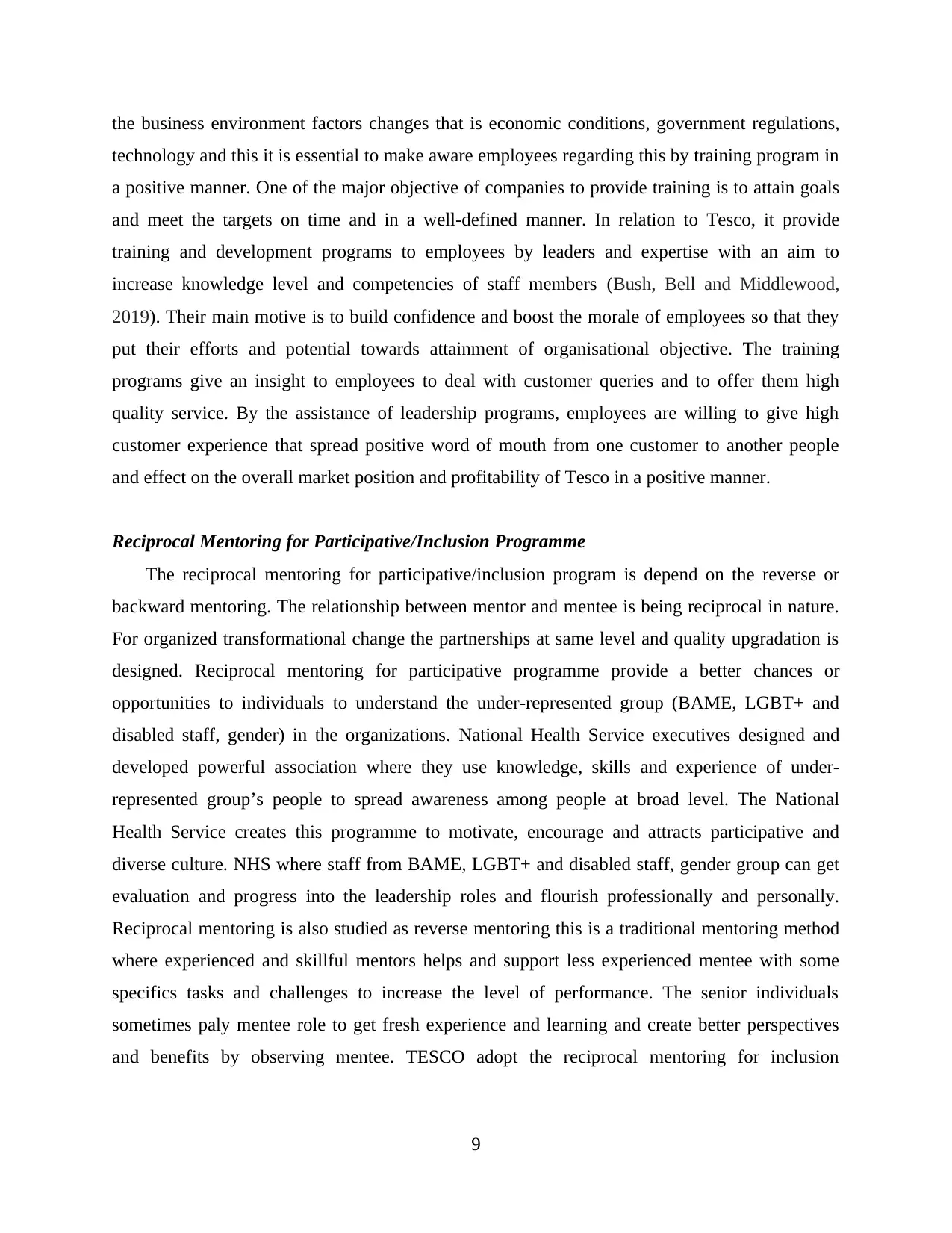
the business environment factors changes that is economic conditions, government regulations,
technology and this it is essential to make aware employees regarding this by training program in
a positive manner. One of the major objective of companies to provide training is to attain goals
and meet the targets on time and in a well-defined manner. In relation to Tesco, it provide
training and development programs to employees by leaders and expertise with an aim to
increase knowledge level and competencies of staff members (Bush, Bell and Middlewood,
2019). Their main motive is to build confidence and boost the morale of employees so that they
put their efforts and potential towards attainment of organisational objective. The training
programs give an insight to employees to deal with customer queries and to offer them high
quality service. By the assistance of leadership programs, employees are willing to give high
customer experience that spread positive word of mouth from one customer to another people
and effect on the overall market position and profitability of Tesco in a positive manner.
Reciprocal Mentoring for Participative/Inclusion Programme
The reciprocal mentoring for participative/inclusion program is depend on the reverse or
backward mentoring. The relationship between mentor and mentee is being reciprocal in nature.
For organized transformational change the partnerships at same level and quality upgradation is
designed. Reciprocal mentoring for participative programme provide a better chances or
opportunities to individuals to understand the under-represented group (BAME, LGBT+ and
disabled staff, gender) in the organizations. National Health Service executives designed and
developed powerful association where they use knowledge, skills and experience of under-
represented group’s people to spread awareness among people at broad level. The National
Health Service creates this programme to motivate, encourage and attracts participative and
diverse culture. NHS where staff from BAME, LGBT+ and disabled staff, gender group can get
evaluation and progress into the leadership roles and flourish professionally and personally.
Reciprocal mentoring is also studied as reverse mentoring this is a traditional mentoring method
where experienced and skillful mentors helps and support less experienced mentee with some
specifics tasks and challenges to increase the level of performance. The senior individuals
sometimes paly mentee role to get fresh experience and learning and create better perspectives
and benefits by observing mentee. TESCO adopt the reciprocal mentoring for inclusion
9
technology and this it is essential to make aware employees regarding this by training program in
a positive manner. One of the major objective of companies to provide training is to attain goals
and meet the targets on time and in a well-defined manner. In relation to Tesco, it provide
training and development programs to employees by leaders and expertise with an aim to
increase knowledge level and competencies of staff members (Bush, Bell and Middlewood,
2019). Their main motive is to build confidence and boost the morale of employees so that they
put their efforts and potential towards attainment of organisational objective. The training
programs give an insight to employees to deal with customer queries and to offer them high
quality service. By the assistance of leadership programs, employees are willing to give high
customer experience that spread positive word of mouth from one customer to another people
and effect on the overall market position and profitability of Tesco in a positive manner.
Reciprocal Mentoring for Participative/Inclusion Programme
The reciprocal mentoring for participative/inclusion program is depend on the reverse or
backward mentoring. The relationship between mentor and mentee is being reciprocal in nature.
For organized transformational change the partnerships at same level and quality upgradation is
designed. Reciprocal mentoring for participative programme provide a better chances or
opportunities to individuals to understand the under-represented group (BAME, LGBT+ and
disabled staff, gender) in the organizations. National Health Service executives designed and
developed powerful association where they use knowledge, skills and experience of under-
represented group’s people to spread awareness among people at broad level. The National
Health Service creates this programme to motivate, encourage and attracts participative and
diverse culture. NHS where staff from BAME, LGBT+ and disabled staff, gender group can get
evaluation and progress into the leadership roles and flourish professionally and personally.
Reciprocal mentoring is also studied as reverse mentoring this is a traditional mentoring method
where experienced and skillful mentors helps and support less experienced mentee with some
specifics tasks and challenges to increase the level of performance. The senior individuals
sometimes paly mentee role to get fresh experience and learning and create better perspectives
and benefits by observing mentee. TESCO adopt the reciprocal mentoring for inclusion
9
⊘ This is a preview!⊘
Do you want full access?
Subscribe today to unlock all pages.

Trusted by 1+ million students worldwide

programme that help in change organizational standards and individual behaviour by maintaining
good relationship and culture in the organization.
Benefits of the Programme –
The main aim of this programme is to develop and create a culture where every executive
director of the NHS enters into a reciprocal mentoring partnership with someone from an under-
represented group (BAME, LGBT+ and disabled staff, gender) within their or another
organization. This programme spread awareness and make social changes and provide various
opportunities to under-represented groups with the help of NHS and other organizations. Tesco
maintain good relationship between their mentor and mentee. Tesco is operating in a number of
countries and have employee working from a number of communities and social diversification,
this helps them to benefit those employees. This helps in bringing a change where in all those
who are from minority groups can be brought up and given a life where they are considered to be
equal of others. Reciprocal mentoring for inclusion programme mainly focuses on bringing
equality in the organizations. This programme creates culture where social and cultural
differentiation are not considerable. Reciprocal mentoring programme shift the primary culture
to one where the power of inequality is admired and valued, and where assumptions and
insensible biases are challenged to benefit the organizations.
The Individual
Benefits of mentor
• This programme is beneficial for the mentor this help in building partnership of mentor at
board level and associate work to change the organization for better.
• This also develop leadership skills in mentor by providing opportunities to manage mentee give
them career advice and develop opportunities for them in order to progress their leadership
development, which improve their performance and raise profit.
• Ability to directly come up with the censorious work required within the organization to
authorize highest level of participative and diverse representation from management group
within superior leadership teams.
• In this programme mentor get chance to observe and examine the board activities and tasks
also discuss the way in which power and politics works.
• This provide good and better understanding of the way in which individuals power works at
responsive and senseless level.
10
good relationship and culture in the organization.
Benefits of the Programme –
The main aim of this programme is to develop and create a culture where every executive
director of the NHS enters into a reciprocal mentoring partnership with someone from an under-
represented group (BAME, LGBT+ and disabled staff, gender) within their or another
organization. This programme spread awareness and make social changes and provide various
opportunities to under-represented groups with the help of NHS and other organizations. Tesco
maintain good relationship between their mentor and mentee. Tesco is operating in a number of
countries and have employee working from a number of communities and social diversification,
this helps them to benefit those employees. This helps in bringing a change where in all those
who are from minority groups can be brought up and given a life where they are considered to be
equal of others. Reciprocal mentoring for inclusion programme mainly focuses on bringing
equality in the organizations. This programme creates culture where social and cultural
differentiation are not considerable. Reciprocal mentoring programme shift the primary culture
to one where the power of inequality is admired and valued, and where assumptions and
insensible biases are challenged to benefit the organizations.
The Individual
Benefits of mentor
• This programme is beneficial for the mentor this help in building partnership of mentor at
board level and associate work to change the organization for better.
• This also develop leadership skills in mentor by providing opportunities to manage mentee give
them career advice and develop opportunities for them in order to progress their leadership
development, which improve their performance and raise profit.
• Ability to directly come up with the censorious work required within the organization to
authorize highest level of participative and diverse representation from management group
within superior leadership teams.
• In this programme mentor get chance to observe and examine the board activities and tasks
also discuss the way in which power and politics works.
• This provide good and better understanding of the way in which individuals power works at
responsive and senseless level.
10
Paraphrase This Document
Need a fresh take? Get an instant paraphrase of this document with our AI Paraphraser
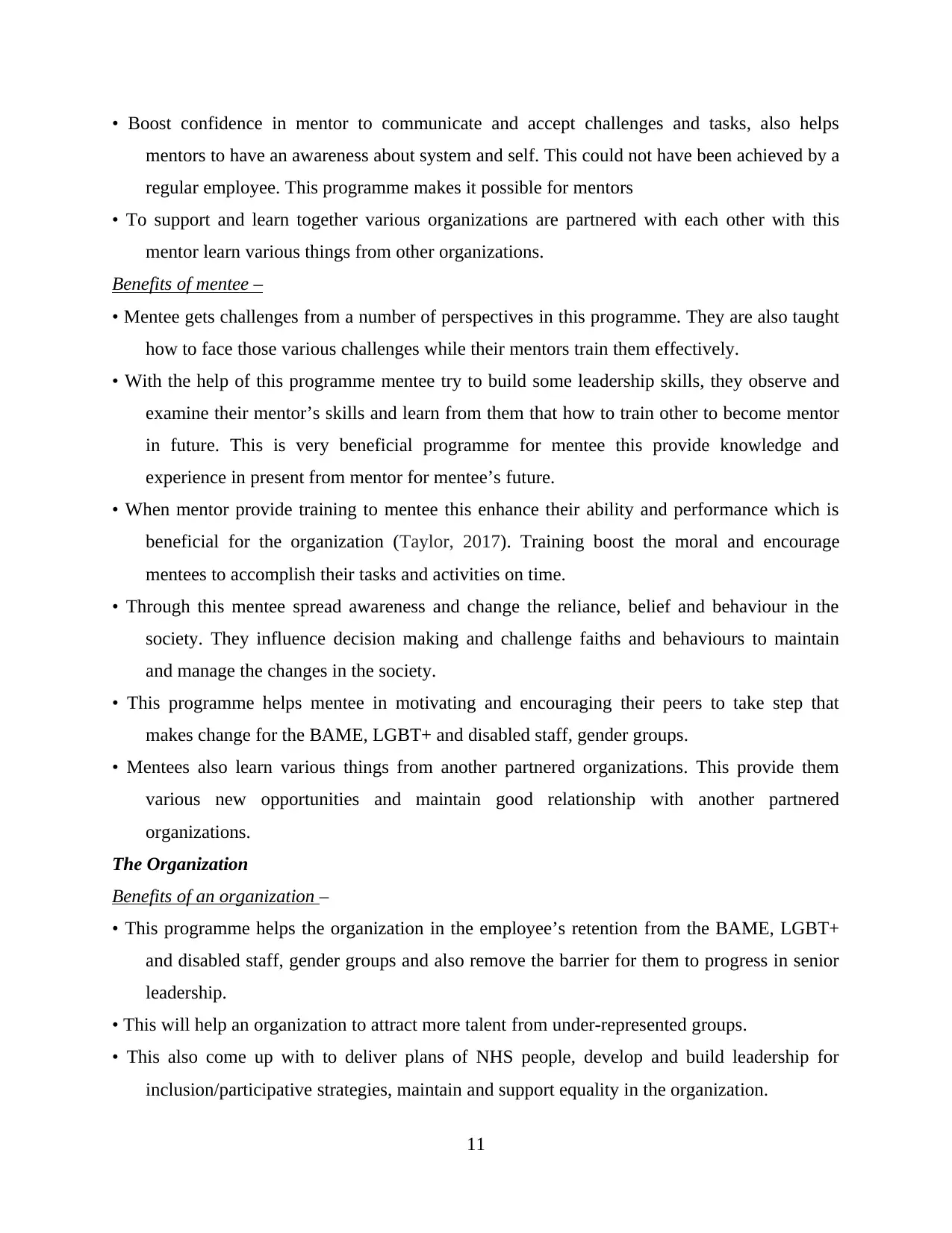
• Boost confidence in mentor to communicate and accept challenges and tasks, also helps
mentors to have an awareness about system and self. This could not have been achieved by a
regular employee. This programme makes it possible for mentors
• To support and learn together various organizations are partnered with each other with this
mentor learn various things from other organizations.
Benefits of mentee –
• Mentee gets challenges from a number of perspectives in this programme. They are also taught
how to face those various challenges while their mentors train them effectively.
• With the help of this programme mentee try to build some leadership skills, they observe and
examine their mentor’s skills and learn from them that how to train other to become mentor
in future. This is very beneficial programme for mentee this provide knowledge and
experience in present from mentor for mentee’s future.
• When mentor provide training to mentee this enhance their ability and performance which is
beneficial for the organization (Taylor, 2017). Training boost the moral and encourage
mentees to accomplish their tasks and activities on time.
• Through this mentee spread awareness and change the reliance, belief and behaviour in the
society. They influence decision making and challenge faiths and behaviours to maintain
and manage the changes in the society.
• This programme helps mentee in motivating and encouraging their peers to take step that
makes change for the BAME, LGBT+ and disabled staff, gender groups.
• Mentees also learn various things from another partnered organizations. This provide them
various new opportunities and maintain good relationship with another partnered
organizations.
The Organization
Benefits of an organization –
• This programme helps the organization in the employee’s retention from the BAME, LGBT+
and disabled staff, gender groups and also remove the barrier for them to progress in senior
leadership.
• This will help an organization to attract more talent from under-represented groups.
• This also come up with to deliver plans of NHS people, develop and build leadership for
inclusion/participative strategies, maintain and support equality in the organization.
11
mentors to have an awareness about system and self. This could not have been achieved by a
regular employee. This programme makes it possible for mentors
• To support and learn together various organizations are partnered with each other with this
mentor learn various things from other organizations.
Benefits of mentee –
• Mentee gets challenges from a number of perspectives in this programme. They are also taught
how to face those various challenges while their mentors train them effectively.
• With the help of this programme mentee try to build some leadership skills, they observe and
examine their mentor’s skills and learn from them that how to train other to become mentor
in future. This is very beneficial programme for mentee this provide knowledge and
experience in present from mentor for mentee’s future.
• When mentor provide training to mentee this enhance their ability and performance which is
beneficial for the organization (Taylor, 2017). Training boost the moral and encourage
mentees to accomplish their tasks and activities on time.
• Through this mentee spread awareness and change the reliance, belief and behaviour in the
society. They influence decision making and challenge faiths and behaviours to maintain
and manage the changes in the society.
• This programme helps mentee in motivating and encouraging their peers to take step that
makes change for the BAME, LGBT+ and disabled staff, gender groups.
• Mentees also learn various things from another partnered organizations. This provide them
various new opportunities and maintain good relationship with another partnered
organizations.
The Organization
Benefits of an organization –
• This programme helps the organization in the employee’s retention from the BAME, LGBT+
and disabled staff, gender groups and also remove the barrier for them to progress in senior
leadership.
• This will help an organization to attract more talent from under-represented groups.
• This also come up with to deliver plans of NHS people, develop and build leadership for
inclusion/participative strategies, maintain and support equality in the organization.
11
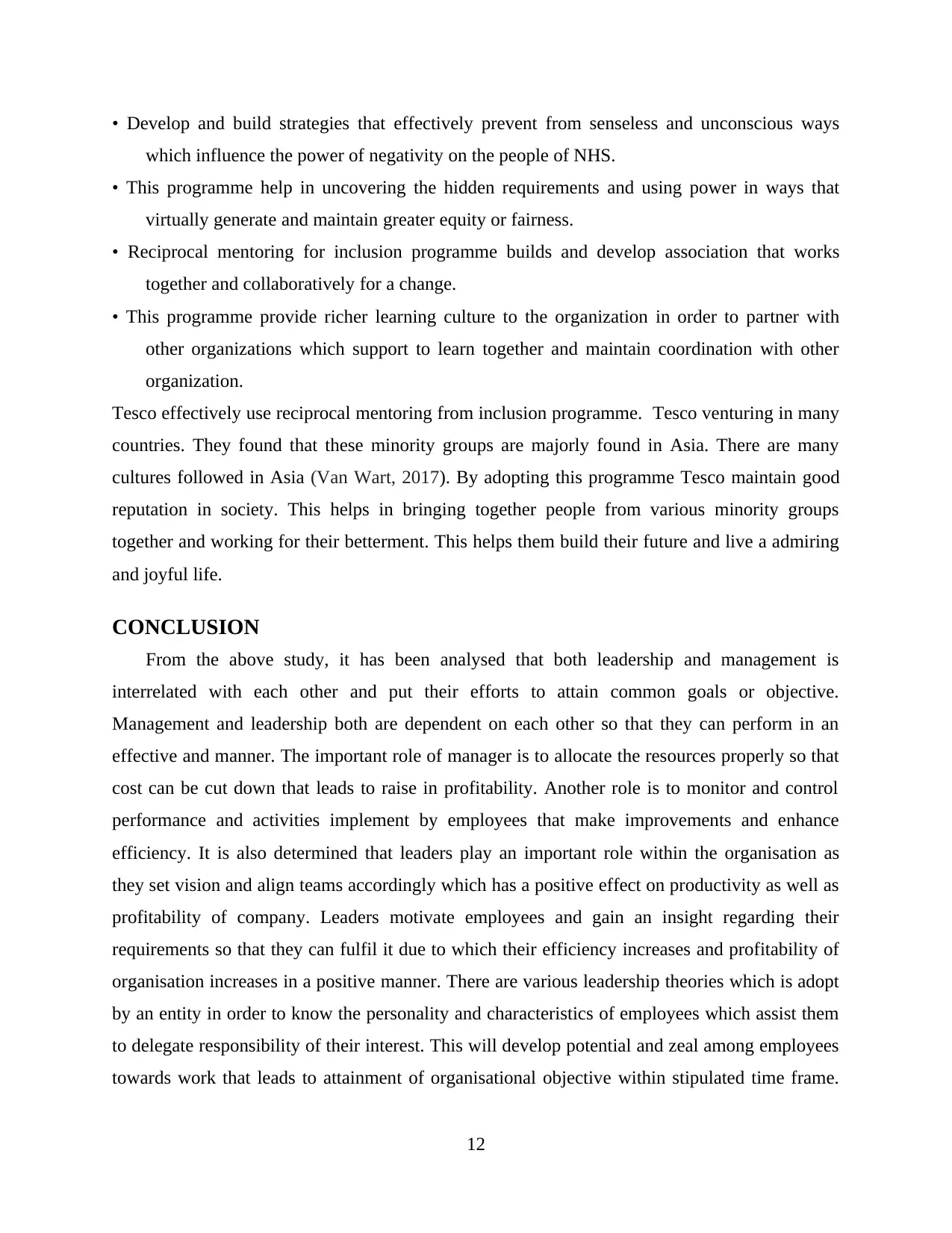
• Develop and build strategies that effectively prevent from senseless and unconscious ways
which influence the power of negativity on the people of NHS.
• This programme help in uncovering the hidden requirements and using power in ways that
virtually generate and maintain greater equity or fairness.
• Reciprocal mentoring for inclusion programme builds and develop association that works
together and collaboratively for a change.
• This programme provide richer learning culture to the organization in order to partner with
other organizations which support to learn together and maintain coordination with other
organization.
Tesco effectively use reciprocal mentoring from inclusion programme. Tesco venturing in many
countries. They found that these minority groups are majorly found in Asia. There are many
cultures followed in Asia (Van Wart, 2017). By adopting this programme Tesco maintain good
reputation in society. This helps in bringing together people from various minority groups
together and working for their betterment. This helps them build their future and live a admiring
and joyful life.
CONCLUSION
From the above study, it has been analysed that both leadership and management is
interrelated with each other and put their efforts to attain common goals or objective.
Management and leadership both are dependent on each other so that they can perform in an
effective and manner. The important role of manager is to allocate the resources properly so that
cost can be cut down that leads to raise in profitability. Another role is to monitor and control
performance and activities implement by employees that make improvements and enhance
efficiency. It is also determined that leaders play an important role within the organisation as
they set vision and align teams accordingly which has a positive effect on productivity as well as
profitability of company. Leaders motivate employees and gain an insight regarding their
requirements so that they can fulfil it due to which their efficiency increases and profitability of
organisation increases in a positive manner. There are various leadership theories which is adopt
by an entity in order to know the personality and characteristics of employees which assist them
to delegate responsibility of their interest. This will develop potential and zeal among employees
towards work that leads to attainment of organisational objective within stipulated time frame.
12
which influence the power of negativity on the people of NHS.
• This programme help in uncovering the hidden requirements and using power in ways that
virtually generate and maintain greater equity or fairness.
• Reciprocal mentoring for inclusion programme builds and develop association that works
together and collaboratively for a change.
• This programme provide richer learning culture to the organization in order to partner with
other organizations which support to learn together and maintain coordination with other
organization.
Tesco effectively use reciprocal mentoring from inclusion programme. Tesco venturing in many
countries. They found that these minority groups are majorly found in Asia. There are many
cultures followed in Asia (Van Wart, 2017). By adopting this programme Tesco maintain good
reputation in society. This helps in bringing together people from various minority groups
together and working for their betterment. This helps them build their future and live a admiring
and joyful life.
CONCLUSION
From the above study, it has been analysed that both leadership and management is
interrelated with each other and put their efforts to attain common goals or objective.
Management and leadership both are dependent on each other so that they can perform in an
effective and manner. The important role of manager is to allocate the resources properly so that
cost can be cut down that leads to raise in profitability. Another role is to monitor and control
performance and activities implement by employees that make improvements and enhance
efficiency. It is also determined that leaders play an important role within the organisation as
they set vision and align teams accordingly which has a positive effect on productivity as well as
profitability of company. Leaders motivate employees and gain an insight regarding their
requirements so that they can fulfil it due to which their efficiency increases and profitability of
organisation increases in a positive manner. There are various leadership theories which is adopt
by an entity in order to know the personality and characteristics of employees which assist them
to delegate responsibility of their interest. This will develop potential and zeal among employees
towards work that leads to attainment of organisational objective within stipulated time frame.
12
⊘ This is a preview!⊘
Do you want full access?
Subscribe today to unlock all pages.

Trusted by 1+ million students worldwide
1 out of 17
Related Documents
Your All-in-One AI-Powered Toolkit for Academic Success.
+13062052269
info@desklib.com
Available 24*7 on WhatsApp / Email
![[object Object]](/_next/static/media/star-bottom.7253800d.svg)
Unlock your academic potential
Copyright © 2020–2025 A2Z Services. All Rights Reserved. Developed and managed by ZUCOL.





